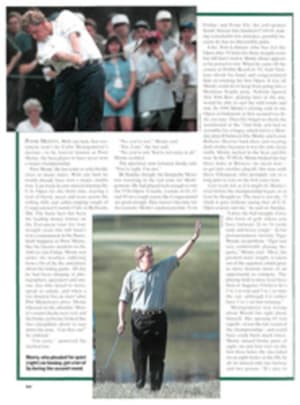
YOUTH MOVEMENT EYE-POPPING PERFORMANCES BY MARION JONES AND MAURICE GREENE BROUGHT NEW LIFE TO THE NATIONALS
They wanted autographs from a runner. Imagine that. Late Sunday
afternoon Marion Jones was leaving the track stadium at Indiana
University-Purdue University in Indianapolis, where in four days
she had turned potential into reality. As she passed through a
chain-link gate, a cluster of children pressed forward, as if
mistaking her for some other famous MJ. She laughed at the
attention, joyfully affixing her name to each item with a
flourish. Sunlight danced off her eyes, framing the face of the
future.
This has been the spring of American track and field's
Armageddon, a post-Olympic apocalypse replete with weekly
pronouncements of impending death. Most suggested cures for the
sport's ills have included buzzwords like "marketing" and
"presentation," spawning the likes of the Donovan Bailey-Michael
Johnson 150-meter world's fastest human travesty in Toronto on
June 1. Then last week the U.S. Track & Field championships
brought to Indianapolis a cache of self-defeating controversy,
including three drug-testing imbroglios and a simmering fight
over the possibility of issuing to injured stars wild-card
invitations to the World Championships in Athens in August.
Riveting stuff. Call it track for C-SPAN. Yet before the weekend
was dead, a remarkable thing had happened: The restorative power
of youth rendered the sludge meaningless.
There was the 21-year-old Jones, the former California high
school wunderkind who had spent three years as a full-time
basketball star at North Carolina while dabbling at track and
field. She took out two of the grandes dames of the U.S. over
the weekend, beating Gail Devers (symbolically) in the 100
meters and Jackie Joyner-Kersee (actually) in the long jump, to
instantly become a threat to win both events in Athens. And
there was Maurice Greene, a 22-year-old who shaved almost .2 of
a second from his personal best in winning the 100 meters in
9.90, a time that has been surpassed by just two other Americans.
It was Jones who jolted the national meet to life by torching
one 100 semifinal heat in 10.92 seconds last Thursday night
(only seven U.S. women had run faster), while Devers won her
prelim heat in 10.99 and her semifinal in 11.15. The next night
Jones won the final in 10.97, despite running into a headwind,
shutting down 10 meters short of the finish and cruising across
the line. Two-time Olympic gold medalist Devers had pulled out
of the final with what her coach, Bobby Kersee, said was a calf
injury.
Kersee didn't pull his wife, Jackie, out of Sunday's long jump,
which gave Jones the opportunity to deprive the 35-year-old
Joyner-Kersee of her eighth consecutive national title. She did
so in spectacular style, beating the 1988 Olympic champion by
one inch with a jump of 22'9", after Joyner-Kersee had taken the
lead on her fifth leap.
In all it was a stunning coming out party for Jones, who had
tasted national prominence in years past--she was fourth in the
1992 Olympic trials 200 and fifth in the 100 as a high school
junior--but remained largely an enigma, at least as far as track
and field went. She started for three seasons as a 5'10" point
guard at North Carolina and was a key member of the Tar Heels'
1994 NCAA championship team. In the springs of '94 and '95 she
struggled through abbreviated track seasons after basketball;
despite making All-America both years, she did not approach her
phenomenal high school form.
"I tried to tune out track and field; that was the easiest way
to get through it for me," said Jones on Sunday as she walked
from the stadium with her boyfriend, Olympic shot-putter C.J.
Hunter. "But the love never died. Every time there was a
national championship or some other big meet, I'd remember what
it was like, and I'd miss being at that level. I was envious. I
knew I could be there."
Jones's plan was to redshirt in basketball for the 1995-96
season and focus on qualifying for the '96 Olympics, but a
broken foot in August '95 killed that idea. She sat out that
basketball season, played all of last season and then began
training with Raleigh, N.C.-based coach Trevor Graham, a
Jamaican who won a silver medal in the 4x400-meter relay at the
1988 Games. Under Graham, Jones has made swift improvement in
her running mechanics. She also has lost, according to Graham,
"between five and 10 pounds," with a diet stripped of junk food,
and in general has adopted the mien of a professional runner
during the 13 weeks leading to the nationals. (Jones graduated
from North Carolina in May with a bachelor's degree in
communications.)
"She's grown up," says Curtis Frye, the sprint coach at North
Carolina. "She's one of those athletes who is just different.
I've seen her run 2:10 for 800 meters. I've seen her run 4.6 for
a 40 with football players, and then the football players
stopped running with her. I've seen her dunk a basketball. She's
going to do things in track and field that only a few athletes
have ever done."
Greene may do the same. As a senior at F.L. Schlagle High in
Kansas City, Kans., in 1993, he won state titles in the 100, 200
and 400. He then spent a year each at Park College in Parkville,
Mo., and Kansas City, Kansas Community College. His talent
surfaced occasionally, as it did in his upset of Carl Lewis in
the 100 at the '95 Texas Relays. Greene ran a wind-aided 9.88
seconds in winning that race. Thereafter, when he signed
autographs, Greene would inscribe a large "9.88" next to his
name and add a tiny w at the bottom, the universal track-nut
symbol for a wind-aided time. In search of consistency after his
second-round exit at last year's U.S. Olympic Trials, he moved
from Kansas City to Los Angeles in September to train under 1972
Olympian John Smith. "I needed to learn," says Greene.
With the learning has come suffering. There is a high pressure
quotient to the practices that Smith runs each day on the UCLA
track, what with the coach digging at Greene's psyche and
Olympic sprinters Ato Boldon and Jon Drummond dishing nonstop
trash. "It's not for the fainthearted," says Smith. Boldon has
often taken Greene to his Beverly Hills home to watch videotape
of their races and workouts. Boldon rose from his seat last
Saturday evening when Greene sailed through the finishing tape
with his first national title and felt tears welling behind his
sunglasses.
Greene has this effect on people. Al Hobson coached Greene for
14 years in Kansas City and found it hard to let him leave last
fall. "He's like my son," Hobson said after Greene's race. When
the two found each other in the twilight, the 57-year-old Hobson
wept openly, and on balance the whole scene beat the heck out of
marketing.
COLOR PHOTO: BILL FRAKES Jones (1160) won the 100 in 10.97, and her 10.92 in the semis was the world's best by a woman this year. [Marion Jones and others in race]

